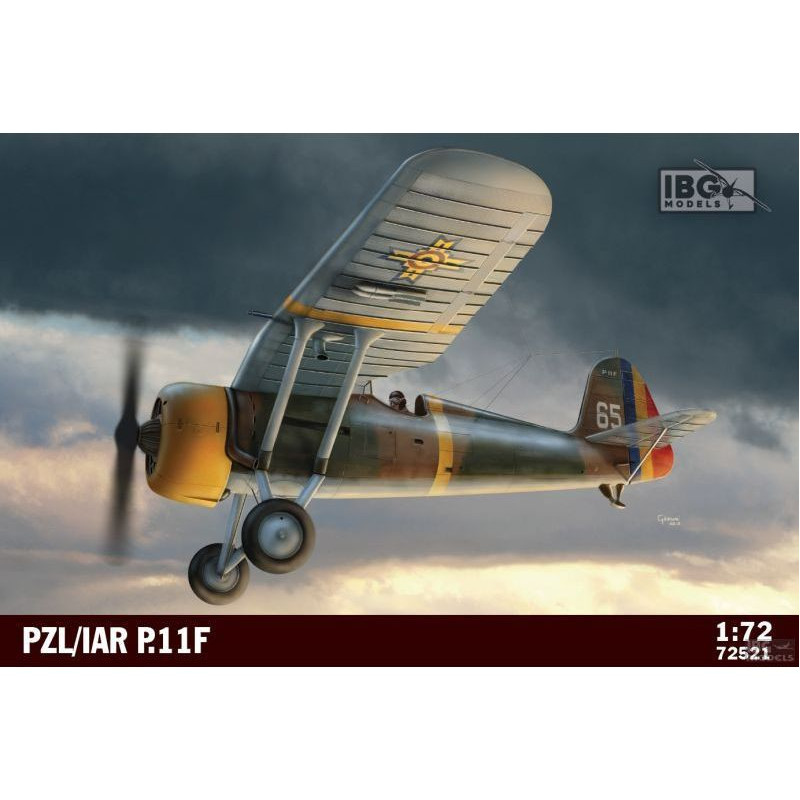The P.11F was the third (after the P.11c and P.7a) most numerous version in a long line of PZL fighters based on Eng. Zygmunt Pulawski's gull wing concept.
Its history begins in the fall of 1934, when, after developing a new, significantly modified version of the P.11 fighter (P.11c - see IBG kit no. 72519), the PZL factory began efforts to attract foreign customers for the aircraft. The first step was the presentation of the fifth P.11 prototype (P.11/V) at the Paris Air Salon in November and December 1934. Romania, which had previously purchased 50 aircraft of the P.11B version from PZL (see IBG kit no. 72518), decided to purchase a production license for the latest variant, which was to be built at Industria Aeronautică Română (IAR) in Braşov. The order was placed in early 1935 - the PZL factory was to provide documentation, a complete prototype, and prefabricated and spare parts kits equivalent to 10 airframes. However, the deal dragged on due to numerous political and financial obstacles. In the end, the aforementioned prototype (P.11/V with engine changed to IAR 9K) was not handed over to the Romanian side until early 1936.
Production, launched with the support of Polish engineers, began in late 1936 and was based in part on products manufactured in Poland - the most notable being Szomansky propellers and Stomil tires.
Compared to the P.11c, the Romanian version differed in its engine and its cowlings (IAR 9K with 600 hp), propeller, armament (4x 7.92 mm FN Browning Modèle 1932, which, due to its rapid firing rate, made the P.11F the best-armed version of the P.11), sights, Romanian flight instruments and other minor equipment details.
The start of production of the all-metal P.11F with a partially half-shell fuselage represented a significant technological change for the IAR factory, which until then had only produced airframes of mixed construction with truss fuselages. The newly gained experience in all-metal construction proved invaluable to the Romanian aerospace industry and ultimately bore fruit a few years later during the construction of Romania's most famous aircraft, the IAR 80.
As a result of the aforementioned delays, the first P.11F fighters were not introduced into first-line units of the Romanian Air Force until July 1937.The last, ninety-fifth, aircraft produced was handed over in November 1938.Due to the rapid development of aviation technology, it was no longer the newest design, but compared to the aviation of other Balkan countries, the 95th Romanian P.11F was a significant force. In 1939, however, much more powerful adversaries appeared on the horizon.
The P.11Fs were ready to defend the Romanian skies during the crises of 1940 (when the Soviet Union occupied Bessarabia in June and between July and September during the dispute with Hungary over Transylvania), the invasion of Yugoslavia in April 1941, and finally took an active part in Operation Barbarossa - performing mainly ground missions. At the end of that year, they were withdrawn from the Eastern Front and transferred to Romanian air defense and training units. Eventually, the last units in schools ended their service in 1948.
In addition to one prototype built at the PZL factory, 95 machines were produced at the IAR factory in Brasov (numbers 51-145) between 1936 and 1938. Unfortunately, no P.11F fighter survives to this day.
The only surviving P.11c aircraft is in the Aviation Museum in Krakow, Poland; it was produced in 1935 and belonged to the 121st Fighter Squadron (side number 2 and sub-wing number 39-K).
- Want to learn more about this magnificent aircraft ? See HERE.
Plastic model to be glued together by IBG. The kit does not include paint and glue.
Specifications:
- scale: 1/72
- product code: 72521
- manufacturer: IBG Models
For more information about the model, photos and descriptions, visit the manufacturer's website (link in the tab above)
A bit of history on the video:
P.11C in the museum:
Taxiing, firing, engine operation....:




























